|
Electro-Mechanical /Solid
State / Econolite / Multisonics /
Eagle
/ Traconex / Other
Electro-mechanical
Controllers
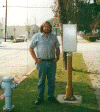 Here is a picture of a 1959 Econolite traffic controller. This is an
"electromechanical" type. This means that the controller uses synchronous motors
and an electrical magnetic coil to energize and
de-energize a solenoid, which in
turn, advances rows of preset cams and contacts (one for each lamp) to
mechanically change the signal lamps. It's kind of fascinating to watch. A Lot of
human ingenuity was involved to make this controller function so well and fairly
reliably in it's time. There are still quite a few of these in operation today,
although their numbers are slowly dwindling.
Here is a picture of a 1959 Econolite traffic controller. This is an
"electromechanical" type. This means that the controller uses synchronous motors
and an electrical magnetic coil to energize and
de-energize a solenoid, which in
turn, advances rows of preset cams and contacts (one for each lamp) to
mechanically change the signal lamps. It's kind of fascinating to watch. A Lot of
human ingenuity was involved to make this controller function so well and fairly
reliably in it's time. There are still quite a few of these in operation today,
although their numbers are slowly dwindling.
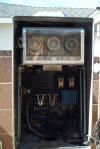 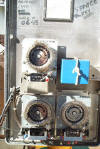 Here
is a view of the inside of the
Econolite version of the
electromechanical cabinet. It
shows the inner workings and
dial motors on the top shelf,
and the flash and dial
transfer relays below. The
shelf pulls forward and the
dust cover is removable for
servicing. Also, located on
the inside door are the time
clocks for intersection flash
(late night flash) and for
time-of-day changing of the
cycle dials. These are
mechanical as well and had a
feature where, if power were
interrupted, the clocks will
continue to operate for
several hours. Here
is a view of the inside of the
Econolite version of the
electromechanical cabinet. It
shows the inner workings and
dial motors on the top shelf,
and the flash and dial
transfer relays below. The
shelf pulls forward and the
dust cover is removable for
servicing. Also, located on
the inside door are the time
clocks for intersection flash
(late night flash) and for
time-of-day changing of the
cycle dials. These are
mechanical as well and had a
feature where, if power were
interrupted, the clocks will
continue to operate for
several hours.

Close up view of the three
dial motors. Note that the
center dial on Econolite units
is dial 1. The left dial
is dial two and the right is
dial three.
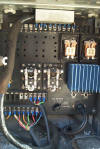
This view shows the
terminal facilities and back
panel. The top right relays
are the flash transfer relays
and break the connection of
the red (or yellow) terminals
and switch the signals over to
flash condition. The blue box
on the right is the solid
state flasher unit that
enables the signals to run in
flash. The center two relays
are the dial transfer relays
and they are of the latching
type. Depending on the black
knob below, or a time clock,
the relays are energized and
dial two or three can be
selected. When no dials are
selected, dial one runs as the
default.
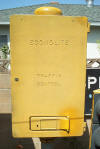 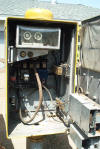
Large Econolite
Electromechanical Cabinet-
These cabinets were used later
in the timeline as signalized
intersections became more
complex and needed more phases
and signal circuits.
This controller controls one
turn movement along with two
other phases.
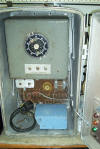
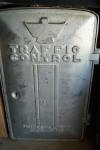
Here is an example of one of the older Eagle
electro mechanicals. The dial motors on these units are run
by a
magnetic disc that spins and interlocks with other gears to
provide a very accurate cycle
for its time. Motors had not been used yet on
these units. This controller is from the 40's.
These units tended to "stick"
in the winter time.
 
The inside
views of this old controller
showing the dial gear
mechanism and a view of the
cam drum with signal contacts.
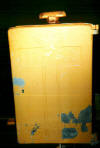
Eagle EF-20 electromechanical
controllers were one of the more popular pre-timed controllers
during the last 50 years. They had a very good reputation and
track record as one of the lowest maintained signal controllers.
Thus, they became very popular throughout the United States.
There are still many of these controllers working even today!
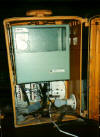
The dial motor and cam assembly is
located in a separate box that is wired with a harness to the
terminal panel in the back. The Eagle version of the dial motor
box was kept very clean from dirt with this latching, dust-free
box. This was part of the "reliability" in design!
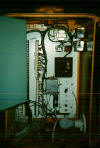
The terminal panel, flash transfer relays and
electro-mechanical flasher are located in the back of the
cabinet. The dial motor box swings away easily, providing access
to all field wire terminals. The light bulb in the lower right
serves two purposes. One is for illumination at night, the other
is to provide heat during winter months.
View of another EF-20 showing the dial motors and time clock
enclosure mounted on the door. Eagle dials are numbered sequentially from left
to right..1,2,3.
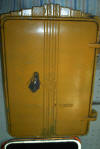 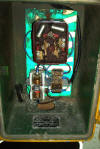 And
here is a Crouse Hinds
electromechanical flasher. The
cabinet sports the familiar
"Art Deco" design, while
inside the mechanics are
fairly simple...with a motor
driven cam and two contacts
that open and close
alternately, giving one a dual
"wig-wag" flash. This
rehabilitated unit was mounted
on an old street sign. And
here is a Crouse Hinds
electromechanical flasher. The
cabinet sports the familiar
"Art Deco" design, while
inside the mechanics are
fairly simple...with a motor
driven cam and two contacts
that open and close
alternately, giving one a dual
"wig-wag" flash. This
rehabilitated unit was mounted
on an old street sign.

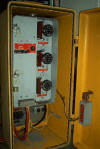 This
is the Crouse-Hinds PCE-1000. This controller is a bit different, in that
the dials are vertically mounted and use a motor driven cam shaft instead of
magnetic. Crouse-Hinds also used many relays to change dials and perform
different functions. This particular unit is very quiet running and has been fun
to refurbish. This
is the Crouse-Hinds PCE-1000. This controller is a bit different, in that
the dials are vertically mounted and use a motor driven cam shaft instead of
magnetic. Crouse-Hinds also used many relays to change dials and perform
different functions. This particular unit is very quiet running and has been fun
to refurbish.
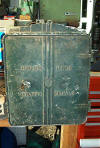 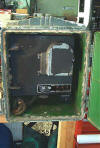 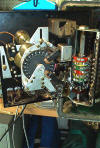
And this is my newest acquisition, the Crouse-Hinds KS-2. This is probably
one of the oldest controllers in my collection. It features a magnetic
disc that is synchronized to the power frequency. This controller is fun to
watch, because there is a brief period of darkness between the signal colors
while changing. This is due to the previous indication's contact breaking
connection before the next one is engaged.

Electro-Mechanical / Solid State /
Econolite / Multisonics /
Eagle
/ Traconex / Other
[Back to Controllers
Page]
All
contents
©1997-2012 by Signalfan. All rights
reserved.
|